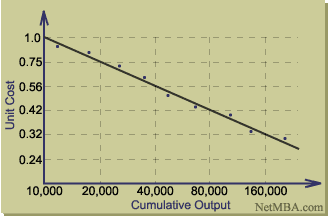In the 1960's, management consultants at The Boston Consulting Group observed a consistent relationship between the cost of production and the cumulative production quantity (total quantity produced from the first unit to the last). Data revealed that the real value-added production cost declined by 20 to 30 percent for each doubling of cumulative production quantity:
The Experience Curve

The vertical axis of this logarithmic graph is the real unit cost of adding value, adjusted for inflation. It includes the cost that the firm incurs to add value to the starting materials, but excludes the cost of those materials themselves, which are subject the experience curves of their suppliers.
Note that the experience curve differs from the learning curve. The learning curve describes the observed reduction in the number of required direct labor hours as workers learn their jobs. The experience curve by contrast applies not only to labor intensive situations, but also to process oriented ones.
The experience curve relationship holds over a wide range industries. In fact, its absence would be considered by some to be a sign of possible mismanagement. Cases in which the experience curve is not observed sometimes involve the withholding of capital investment, for example, to increase short-term ROI. The experience curve can be explained by a combination of learning (the learning curve), specialization, scale, and investment.
Implications for Strategy
The experience curve has important strategic implications. If a firm is able to gain market share over its competitors, it can develop a cost advantage. Penetration pricing strategies and a significant investment in advertising, sales personnel, production capacity, etc. can be justified to increase market share and gain a competitive advantage.
When evaluating strategies based on the experience curve, a firm must consider the reaction of competitors who also understand the concept. Some potential pitfalls include:
The fallacy of composition holds: if all other firms equally pursue the strategy, then none will increase market share and will suffer losses from over-capacity and low prices. The more competitors that pursue the strategy, the higher the cost of gaining a given market share and the lower the return on investment.
Competing firms may be able to discover the leading firm's proprietary methods and replicate the cost reductions without having made the large investment to gain experience.
New technologies may create a new experience curve. Entrants building new plants may be able to take advantage of the latest technologies that offer a cost advantage over the older plants of the leading firm.

No comments:
Post a Comment